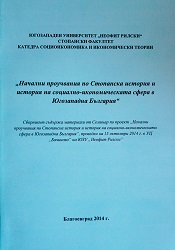СОЦИАЛНО-ИКОНОМИЧЕСКА ХАРАКТЕРИСТИКА НА ВЪЗРОЖДЕНСКИЯ МЕЛНИК
SOCIOECONOMIC CHARACTERISTIC OF THE REVIVAL MELNIK
Author(s): Dimitar Christov
Subject(s): Economy
Published by: ЮГОЗАПАДЕН УНИВЕРСИТЕТ »НЕОФИТ РИЛСКИ«
Keywords: Melnik; Renaissance; Social History; Economy; Agriculture; Lozarovinarstvo; Crafts; Trade
Summary/Abstract: The history of the town of Melnik between 17th – early 20th c. has been only partly studied by the Bulgarian scholars. Nevertheless its importance is beyond question. The question is widely covered by Greek authors, however their works are relatively unknown in Bulgaria and generally suffer from a national bias in the treatise. The present paper inquires into some aspects of this history, using the socio-economic approach rather than the national-historical one. The following major issues are treated: General development of Melnik during the Ottoman period; Population of the town and the close region (the kaza); Town economy; and Commerce. The first section presents a brief historical sketch starting with the Ottoman invasion (late14th c.), going through the rise of Melnik during the Balkan Revival (17th – 19th c.) and ending with the demographic collapse of the town in the Balkan Wars (1912-1913). The second section deals with demographic questions in the given order: Number of people and houses in the town, number of people in the kaza, Confessions and nationalities represented in Melnik, Social and class structure of the town dwellers. The economic section includes the following articles: Agriculture; Viticulture and Winemaking; Other Plant Cultures; Animal Breeding; Use of Forests and Other Natural Resources; Crafts and Industry. Commerce, because of its importance for the Melnik inhabitants, is an object of a section separate from the other economy. The issues covered here are: Roads of communication and trade; Town marketing; Domestic trade (within the range of the Balkan provinces of the Ottoman Empire); and Foreign trade. In the conclusion, there is an attempt to outline the main trends of the social and the economic development of Melnik during the period from the 17th c. up to the Balkan wars (1912-1913). Considering the struggling economy of the present day Melnik, the paper aims to point out on those positive examples of its past, which could attract a larger attention for the town and its people.
- Page Range: 147-176
- Page Count: 30
- Publication Year: 2014
- Language: Bulgarian
- Content File-PDF

